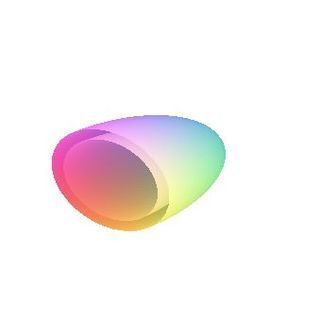Top Qs
Timeline
Chat
Perspective
Homoeoid and focaloid
Geometric shell bounded by two concentric, similar ellipses or ellipsoids From Wikipedia, the free encyclopedia
Remove ads
A homoeoid or homeoid is a shell (a bounded region) bounded by two concentric, similar ellipses (in 2D) or ellipsoids (in 3D).[1][2] When the thickness of the shell becomes negligible, it is called a thin homoeoid. The name homoeoid was coined by Lord Kelvin and Peter Tait.[3] Closely related is the focaloid, a shell between concentric, confocal ellipses or ellipsoids.[4]


Remove ads
Mathematical definition
Summarize
Perspective
If the outer shell is given by
with semiaxes , the inner shell of a homoeoid is given for by
and a focaloid is defined for by
The thin homoeoid is then given by the limit , and the thin focaloid is the limit .[3]
Remove ads
Physical properties
Thin focaloids and homoeoids can be used as elements of an ellipsoidal matter or charge distribution that generalize the shell theorem for spherical shells. The gravitational or electromagnetic potential of a homoeoid homogeneously filled with matter or charge is constant inside the shell, so there is no force on a test particle inside of it.[5] Meanwhile, two uniform, concentric focaloids with the same mass or charge exert the same potential on a test particle outside of both.[4][1]
Remove ads
See also
References
External links
Wikiwand - on
Seamless Wikipedia browsing. On steroids.
Remove ads








